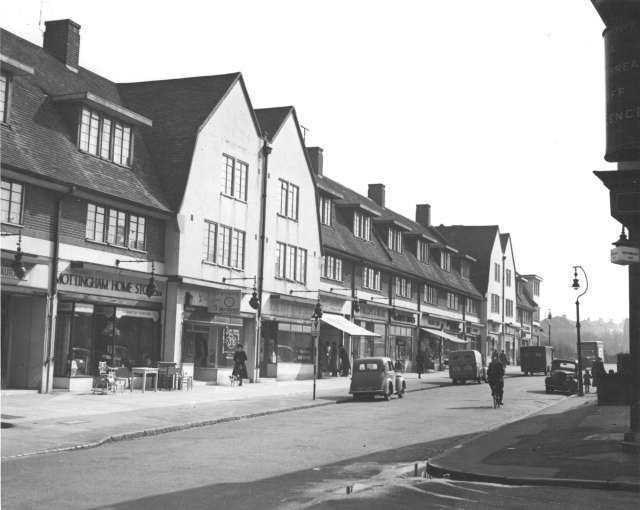OS grid reference TQ415725 Ceremonial county Greater London | London borough BromleyGreenwich Country England Dialling code 020 Post town London | |
 | ||
Population 9,987 (2011 Census. Mottingham and Chislehurst North Ward) UK parliament constituencys Bromley and Chislehurst, Lewisham East, Eltham | ||
Mottingham is a district of south east London inside the London boroughs of Bromley and Greenwich. It is located south of Eltham, and 9 miles (14.5 km) southeast of Charing Cross.
Contents
- Map of Mottingham London UK
- Toponymy
- Local government
- Landmarks
- Geography
- Mottingham Estate
- Transport
- Notable residents
- References
Map of Mottingham, London, UK
Toponymy
The earliest records of Mottingham are from 862 AD when it was recorded as Modingahema, which means the land of Moda's people and is commonly interpreted as "the proud place".
In the seventeenth century Thomas Fuller recorded in The Worthies of England a curious incident that happened on 4 August 1585:
"...in the Hamlet of Mottingham (pertaining to Eltham in this county) in a Field which belongeth to Sir Percival Hart. Betimes in the morning the ground began to sink, so much that three great Elm trees were suddenly swallowed into the Pit; the tops falling downward into the hole; and before ten of the clock they were so overwhelmed, that no part of them might be discovered, the Concave being suddenly filled with Water. The compasse of the hole was about eighty yards, and so profound, that a sounding line of fifty fathoms could hardly find or feel the bottom."
The cause of the incident, referred to as a "marvellous accident" at the time, was then unknown, and it is likely that a sinkhole had developed. The area is well coursed with streams, both above and below ground, and the collapse or shifting of subsoil might be attributed to them. The site of the sinkhole is now unknown, and the incident is also largely unknown. The only body of standing water that is in the area today is a lake at The Tarn Bird Sanctuary.
In the NW corner of The Tarn opposite Mottingham Station is an ice well dating from about 1760 which supplied Eltham Lodge (now the clubhouse of the Royal Blackheath Golf Course).
Local government
Mottingham was originally a hamlet in Eltham parish, in the Blackheath hundred of Kent. In 1840 it was included in the Metropolitan Police District by the Metropolitan Police Act 1839. A key year in the history of Mottingham was 1866, when the area became connected to the railway system with the construction of Mottingham station (then known as Eltham station). Also in 1866, Mottingham received separate civil parish status, thus separating itself from Eltham. In 1881 the parish had a population of 779 and covered an area of 642 acres (2.60 km2).
When the County of London was created in 1889, Mottingham was excluded from the new county and now formed a protrusion of Kent, bordering London to the west, north and east. From 1894 to 1934 it formed a detached part of the Bromley Rural District and had its own parish council. In 1931 the parish had a population of 2,120. In 1934 the rural district and the Mottingham civil parish were abolished and the area was transferred to Chislehurst and Sidcup Urban District. In 1965 the urban district was abolished and the area was transferred from Kent to Greater London, to form part of the London Borough of Bromley. The boundary between Bromley and Greenwich, and between Bromley and Lewisham, around Mottingham was adjusted in 1994.
Landmarks
The first church in Mottingham was St Andrew's Church on Court Road which was established in 1884, and which further helped establish Mottingham as separate from Eltham. A local landmark is Eltham College, a private school founded in 1842 as the London Missionary Society's School for the Sons of Missionaries, which moved to its present site in Mottingham in 1912. The famous cricketer Dr W. G. Grace lived in retirement for some years in Mottingham – a blue plaque marks his residence, 'Fairmount' in Mottingham Lane where he died on 23 October 1915. He was buried in Beckenham Crematorium.
Geography
Nearest places are:
Mottingham Estate
London County Council bought the Court Farm estate in the early 1930s and planned a 2000 home cottage estate. The first houses were to the west of Mottingham Road and completed in 1935. The estate was fairly self-contained; the community facilities included a shopping centre and several schools.
In 1946 Woolwich Council built to the east of Mottingham Road. The Coldharbour estate was created primarily to provide accommodation for local people made homeless by the blitz. This completed the use of the LCC land.
Transport
Mottingham station serves the district with regular services to London Charing Cross and London Cannon Street via Lewisham and London Bridge. Services also run to London via Sidcup and Woolwich Arsenal as part of a loop service. There are also services to Gravesend. Mottingham is served by several Transport for London bus services linking it with areas including Bromley, Catford, Chislehurst, Eltham, Grove Park, Lee, Lewisham, St Mary Cray, North Greenwich and Woolwich.
